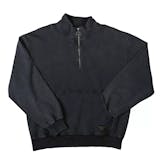Maintenance
GENERAL TIPS
Taking care of your clothes not only makes them last longer but also makes them look better. Here we are some tips:
* Separate the whites from colored clothes in your washing machine.
* Wash clothes back to front.
* Wash them in cold or warm water (not above 30 ° C).
* Do not iron prints or do it with a piece of cloth on top.
* Try not to use a dryer. They wear clothes out and make colors fade faster than if we air dry during the windy part of any day. If you have to use the dryer use it with a delicate or mild program.
* Avoid the direct sunlight in order to minimize the damage to the fabric.
To achieve many of the effects of aging on garments we need to use 'direct' dyes instead of 'reactive' ones. The 'direct' dyes have a lower threshold when washed and can loose some dye, especially in the first few washes. That's why we recommend washing these items separately or with the same color clothes in cold water. There’s a ‘Garment-care’ label in all of our clothes that need to be wash separately.
LEATHER
As the care label shows, garments with the leather patch and leather jackets cannot be laundered. We recommend you to bring them to professional cleaners who can handle leather items.
As a daily maintenance, rush or wipe with a dry cloth to remove any dust or soil from the leather. For stubborn stains or smudges, take a small amount of the leather cleaner on a soft cloth and wipe off.
SHEEPSKIN COLLAR
Pat gently to shake off the dust and soil. For stubborn stains, dissolve soap or neutral detergent in water, soak a soft sponge or a piece of cloth with the liquid and tap gently to remove.
WAX CANVAS
Waxed cotton is a unique high-performance fabric, this wax treatment creates a highly resistant wind and water barrier, while maintaining the breathability of the cotton. Proper care and treatment of your waxed cotton garment will ensure its longevity.
Regular cleaning not only enhances the appearance of your garment but removes dust and dirt that can cause premature wear. Regular cleaning also prevents dirt build-up from becoming irremovable stains.
- Remove dried mud, sand and grit as soon as possible especially along inner sleeve seams, as these are abrasive.
- Soak the entire jacket in cold water or hose it off completely, don't use any soaps or detergents.
- Hang to dry naturally for at least 24 hours in a dry, well-ventilated area.
- Reproof the entire garment after cleaning.
Doing any of the following will damage or remove the proofing:
* Do not machine wash.
* Do not dry clean.
* Do not tumble dry.
* Do not use soap or detergent of any kind.
* Do not use solvents or bleach.
* Do not iron or starch.
* Do not expose to direct sunlight for a long period of time.
Reproofing
• Be sure that the garment is clean and dry. Lay it on a flat surface and apply the wax sparingly with a soft, lint-free cotton cloth.
• Try using a hair dryer to warm the wax on the cloth and on the garment as you apply it. This will make the application easier and more uniform.
• Spread the wax evenly, working it into the fabric in a circular motion. Seams and worn areas will require more wax.
Most waxed cotton garments will need regular reproofing within a year if worn frequently, or even sooner if you notice that the coat is drying out due to exposure to the elements. Uneven, shiny or dry areas, or where moisture no longer beads, is a good indicator to reproof those specific areas. It is not necessary to reproof the entire garment unless it has been washed.
By reproofing your waxed cotton jacket, you can bring back its original water-resistant finish. On top of prolonging the life of your jacket, reproofing will also revive the fabric's colour and help to prevent holes from forming along the seams of your jacket. Garments can be as good as new with an easy application of reproofing wax.
• Be sure that the garment is clean and dry. Lay it on a flat surface and apply the wax sparingly with a soft, lint-free cotton cloth.
• Try using a hair dryer to warm the wax on the cloth and on the garment as you apply it. This will make the application easier and more uniform.
• Spread the wax evenly, working it into the fabric in a circular motion. Seams and worn areas will require more wax.
HATS
Store your felt hat upside down, on a clean and flat surface or in a hat box to keep the brim from flattening out. As daily maintenance, remove dust and loose dirt with a soft brush. If it is light colored and become spotted you can clean it with a piece of cloth, dampened with warm water (do not use chemical products).
If your hat gets wet, shake off the excess of water and dry the hat naturally, don’t place it near heat. While the hat is wet, don’t let the brim touch the surface.
Some hat brims may bend or warp if not hung up or kept on a flat surface. Felt hats can be re-shaped using steam, however we suggest professional help for this operation.
MELOU KNIFES
Clean it after using. To properly clean the blade, use warm water and soap. The handle should be cleaned with a damp cloth and then immediately dried. It is important that the wood isn’t exposed or left soaking in water for too long. Important: Do not put in the dishwasher.
Avoid direct sunlight, the sunlight can dry out the wooden handle of your knife, which can lead to cracking. Store your knife in a drawer.
It is beneficial to apply a small amount of oil to the wooden handle of your knife. Oiling the wooden handle saturates the pores, which prevents water from being absorbed. There are a variety of wood oils you can buy at knife stores, but if you have mineral, walnut, or tung oil, those will work great. Simply add a few drops of your preferred oil to the handle and rub it in with a clean cloth. Allow the oil to be absorbed into the wooden handle for an hour or two. You should oil the handle of your wooden knife at least a few times a year, as it will maintain the longevity and performance of your knife.


